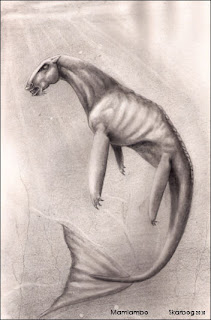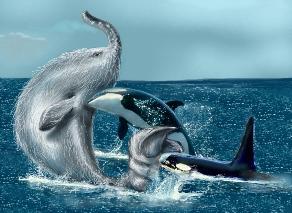So I've been doing all this research about real animals, and as awesome as they are, it's time to shake things up a bit. The easiest way to do this is by delving into the world of cryptid animals. In case you were wondering, a cryptid is a creature (or a plant) whose existence has been suggested but is not currently recognized by scientific consensus. Famous examples include the Yeti from the Himalayas and the Loch Ness Monster from Scotland. South Africa does have some cryptids of its own, and while they may be more obscure than Bigfoot, they are certainly no less important! What if I am all on my own in South Africa and stumble upon a Grootslang, or a Mamlabo? I'll tell you what will happen- I'll take a picture and post it right here on this blog and become unbelievably famous. Dream big, that's all I have to say. Right.
Let's go in alphabetical order, since this blog entry is so rational anyways. The Grootslag is our first cryptid creature, and is said to live in a deep cave known as the "Wonder Hole" or the "Bottomless Pit" in Richtersveld, South Africa. Its name means "big snake" in Afrikaans, which is a good name because the Grootslang is supposedly 40 feet long and 3 feet wide. Its diet includes unsuspecting elephants that are lured into its "Wonder Hole". Supposedly the Grootslang's "Bottomless Pit" connects to the sea, which is approximately 40 miles away. Oh, and also, it is filled to the brim with diamonds. A wealthy English businessman by the name of Peter Grayson mounted an expedition in 1917 to find this fearsome elephant-eating creature. After a series of injuries to his party, he set off on his own, never to be seen again.
 |
| "A" marks the approximate location of the "Wonder Hole" |
The Mamlambo is another snake-like creature, and is a deity in South African and Zulu mythology. It is also known as the "goddess of rivers". It kicked Bigfoot out of the spotlight for a bit in 1997 when some South African newspapers reported on sightings of a "giant reptile" monster in the Mzintlava River near Mount Ayliff. These newspapers reported that the monster had killed at least 9 people. The villagers of the area described the moster to be around 67 feet long, with the torso of a horse, the lower body of a fish, short legs, and the neck of a snake. Furthermore, this creature shined with a green light at night. Surprisingly, 9 bodies were actually found in the Mzintlava River. According to police, they had been in the water for such a long time that the soft parts of their heads and necks were eaten by crabs. Local villagers, on the other hand, claim that these mutilations had been cause by none other than the Mamlambo. After all, it does have a nasty habit of eating faces and "sucking brains out". That last characteristic gives it the pleasant nickname of "the Brain Sucker".
 |
| "A" marks the location of Mount Ayliff |
 |
| An Artistic Rendering of the Mamlambo |
Next up we have the Tikoloshe. According to Zulu mythology, the Tikoloshe (also known as the Hili), is a dwarf-like water sprite. If that description isn't vague enough for you, it also has been said to resembled a zombie or a poltergeist or a gremlin. The process for making a zombie Tikoloshe is very complex; it involves removing the eyes and tongue from a corpse, thrusting a heated iron rod into the skull, and breathing life and obedience into the zombie. And to think, you can do all of this for the small price of the death of relative within the year. Oh, and it has also been portrayed as a bear-like humanoid thing. It may even have gouged-out eyes. It is considered to be a mischievous and evil spirit that can become invisible by swallowing a pebble. Wow, Harry, your invisibility cloak looks like a big hassle now. The Tikoloshe is called upon by malevolent people to cause trouble for others. It can do as little as simply scare a child, or go so far as to cause illness or even death. It also has a tendency to bite sleeping peoples' toes off, and to steal milk from cows. Many people choose to have their beds elevated on bricks just to be sure that the dwarf can reach them (or their toes) while they sleep. The only way to get rid of the bugger is to call the n'anga, or the witch doctor, who has the power to banish him from the area. I'll have to make sure I know where the nearest n'anga is when I head over to Parys.
 |
| Tokoloshes are a very common part of South African Culture, featured here in a "Madam and Eve" comic |
 |
| Notice the Bricks under the bed! |
Next we have the Trunko, also known as the Margate Monster. This one has actually been discredited, but I'll go ahead and tell you all about it anyways. It was first sighted in Margate, South Africa on October 25, 1924. London's
Daily Mail published an article entitled "Fish Like A Polar Bear", reporting that this mystery animal was seen battling two killer whales and lifting itself out of the water by about 20 feet. Apparently, the creature washed up on Margate Beach some time later, but no scientist felt it worthwhile to investigate the carcass despite the fact that it was there for ten days. Some unidentified witnesses described the animal as possessing snowy-white fur, and elephantine trunk, a lobster-like tail, and a carcass lacking blood. While it was beached, it was measured by beach-goers (because that's what I'd like to do on my beach holiday) and found to be 47 feet long, 10 feet wide, and 5 feet high. The length of the trunk was 5 feet and said to be attached directly to the animal's torso, and no head was found on the carcass (thus the name Trunko).

However, in 2010, a German cryptozoologist named Markus Hemmler discovered a photograph of the Trunko and another man named Karl Shuker announced that Trunko had been nothing more than a globster. A globster may sound like another mythical creature, but it actually refers to a massive, tough skin-sac of blubber containing collagen that is occasionally left behind when a whale dies and its skull and skeleton have separated from the skin and sunk. The killer whales were actually tossing the globsterised mass into the air, which is apparently a common practice, and making it look alive. Three more photos of Trunko have been discovered since 2010.
 |
| Trunko AKA Globster |
 |
| A more recent globster |
Last, but certainly not least, we have the Umdhlebi, which is a carnivorous tree. On November 2, 1882, Reverend George G.W. Parker reported that the plant was poisonous in the journal "Nature". Acording to Reverend Parker, Zulus sacrificed sheep and goats to the tree to calm the evil spirit. It is described as having large, fragile green leaves and two layers of bark. The outer layer of bark is dead and hangs off the tree, while the new living layer grows beneath it. The fruit of the tree is supposedly red and black and hangs from the branches like small poles. Parker claimed that the Umdhlebi poisoned animals that came near in order to fertilize the soil in which it was growing with decayed animal remains. Symptoms of Umdhlebi poison include headache and bloodshot eyes.
 |
| Humans are not the usual diet of this tree |
CHEETAH TIME!!!
Back to the land of boring reality. Except we're talking cheetahs, so that's not boring. I didn't want to stray too far from today's theme, so the topic will be white and other unusually colored/cryptid cheetahs. Reports of white cheetahs usually refer to Indian cheetahs. In 1608, the Mughal Emperor of India recording having a white cheetah presented to him. In particular, the Emperor described its spots as being "of a blue colour", and that "the whiteness of the body also inclined to blue-ishness". Apparently this blueish coloring suggests a chinchilla mutation rather than a white cheetah. The chinchilla mutation restricts the amount of pigment in the hair shaft. In other words, there were spots formed of black pigment, but it was less dense pigmentation, giving the animal the hazy, gray-blue color. In 1925, a melanistic cheetah was spotted in Kenya. A melanistic cheetah refers to a cheetah that is black with ghost markings. Red (dark tawny spots on golden background) and Cream cheetahs (pale red spots on pale background) have also been reported. Maltese cheetahs are supposedly pale gray with darker gray spots. The white cheetah, meaning a cheetah with no spots, was thought to be a cryptid until Guy Combs shot the photo below in 2011...











No comments:
Post a Comment